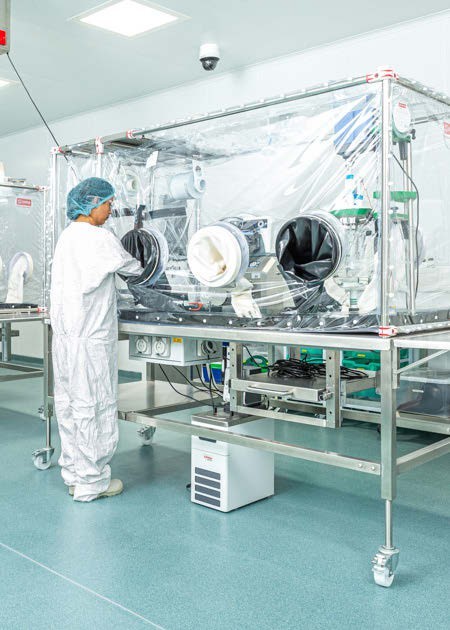Manufacturing: Good Manufacturing Practice
How Flexible Containment Is Helping Manufacturers Meet Demand for Highly Potent Drugs
Manufacturers are deploying flexible containment in both existing and new-build manufacturing sites. Why are they choosing this over traditional rigid isolators, and what are the considerations they should take into account when doing this?
Mark Arnold at ONFAB

The landscape of cancer treatment is changing. Advancements in oncology drugs are now enabling precision treatments that target cancerous cells in specific areas of the body. Trastuzumab, for example, is being applied in breast and stomach cancer treatments. 1
The development of targeted therapies is hugely advantageous – not only because they stop cancer growing, but they also work with the immune system to kill malignant cells. These breakthrough medicines are crucially needed – especially when you consider the WHO’s International Agency for Research on Cancer (IARC) has reported that cancer cases are expected to increase by 29.5 million by 2040.2
A critical element of this medicine, however, is the inclusion of highly potent active pharmaceutical ingredients (HPAPIs). These cytotoxic compounds are safe to administer to patients, but can prove dangerous in manufacturing environments if they are not handled correctly. Mishandling could lead to workers being harmfully exposed or pose the risk of cross-contamination.
Given the growing use of these ingredients, increasingly manufacturers are having to deploy containment equipment in their facilities to enable these drugs to be produced safely. Where manufacturers are working with HPAPIs, they must demonstrate the quality, safety and repeatability of processes to the regulators that oversee the industry.
What Flexible Containment Technology Offers
To ensure this, manufacturers often choose to deploy flexible containment solutions. One of the major advantages of flexible containment technology is the ability to set up solutions at short notice. Individual processes can be quickly retrofitted to separate operators from the ingredients they are handling, and enable consistently safe and repeatable processes.
These flexible solutions are also being deployed as a key element of manufacturers’ containment strategies within new build facilities. Traditionally, manufacturers have opted to install a rigid isolator in new facilities, with this continuing to be a popular option when producing larger batches of the same drug. However, where precision medicines are being produced in smaller batches, there is a growing preference from manufacturers to deploy flexible solutions. There are five key reasons why they are turning to this alternative:
Cleaning and Validation
With a flexible containment approach, manufacturers can remove and safely dispose of elements such as glove bags, which greatly reduces the cleaning and cleaning validation process. This validation is especially important when working with HPAPI drugs as cleaning needs to go down to the submicron level to remove all traces of a compound. The other key advantage to using disposable elements is that the risk of cross-contamination is also removed.
Proven Safety
Flexible technology has been independently tested and proven to achieve less than 1 µg/m3 (OEB 5), supporting the manufacturing of products with OELs in the nanogram range. 3 Asignificant portion of the growth in flexible containment at new build facilities is also being driven by companies that have previously retrofitted existing sites and have confirmed for themselves that the equipment meets high safety standards.
Compliant and Adaptable
Flexible containment technology can also control humidity, temperature, oxygen degradation and UV light management by integrating automated and non-automated control systems. They are also more ergonomically friendly for operators than rigid containment.
This is opening up the possibility of working with a wider range of drugs, including those that are sensitive to light, such as dacarbazine. The adaptability of the technology also means that products can be consistently produced and controlled in line with the quality standards laid out by Good Manufacturing Practice (GMP) regulation.4
Reduced Downtime
Flexible containment ensures minimal downtime, with only a simple engineering change-out required between the production of non-potent and highly potent compounds. When not required, framework and control systems can be easily stored away until they are needed again, while the protective film can be disposed of and replaced after each use.
The Financial Case
Flexible containment also helps businesses avoid the large capital expenditure that comes with installing rigid isolator systems. The cost difference between a contained rigid system and a flexible system is tenfold. If you were to build a rigid process isolator costing around £100,000, an equivalent retrofitted in-process flexible isolator would typically cost £10,000 while achieving the same containment levels. Perhaps the biggest cost-benefits, however, are in the savings made through the cleaning validation process. This is not so much due to the cost of the cleaning in itself, but through the reduced downtime at the production facilities. Manufacturers are no longer losing days while rigid isolators are cleaned and validated between batch runs.
These benefits are the reason why flexible containment solutions have fast become a go-to choice for manufacturers producing HPAPI drugs. This technology now has a big role to play in protecting operators during production as drug manufacturers look to keep up with the global demand for these vital therapies.
References

As managing director of ONFAB, Mark Arnold is responsible for all aspects of the pharmaceutical process containment systems. A member of the Institute of Engineering and Technology for over 20 years, he has an impressive track record of leadership, sales and commercial roles within a number of fast growth global manufacturing firms including RPM International and AIM-listed Elektron Technology (now Checkit).